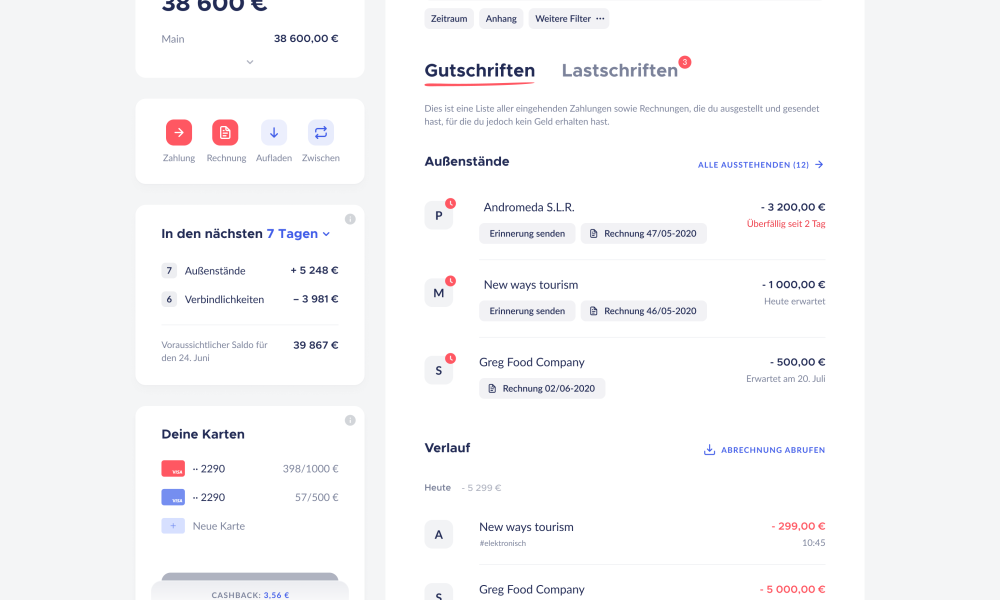When it comes to interest Finoma goes, you can expect a slightly different approach than with classic business accounts.
This is less about good shape, but rather a reward system that can be just as attractive for many users. Let us take a close look at that.
No good shape in Finom: Why this does not have to be a disadvantage
In contrast to traditional banks, there is no good shape lenses at Finom.
That means:
-
Interest on credit: 0.00 % – no matter how high your account balance is, you don’t get interest on your deposits.
-
Negative interest: From a credit of € 100,000, a penalty rate of 0.50 % per year is charged, but only to the part that exceeds this limit.
This means that if you have € 120,000 in the account, for example, only the 20,000 € that is above the border will be calculated. That makes € 100 negative interest rates a year. Doesn’t sound particularly tempting, isn’t it?
Why Finom does not do with credit interest is obvious: As a fintech provider, they rely on transaction fees and their premium tariffs to make money. You also have to pay penalty interest on your partner banks such as BNP Paribas.
The cashback model at Finom as a smart replacement for interest
If you still want to benefit financially with Finom, you simply have to use your card regularly. Because here Finom offers a cashback program instead of classic credit interest: which is impressive:
| Tariff | Cashback set | Maximum cashback/month |
|---|---|---|
| Solo | 0 % | – |
| start | 2 % | 10 € |
| Premium | 3 % | 20 € |
| Corporate | 3 % | 50 € |
To put it in numbers: If you use the start tariff and issue € 500 per month with your card, you will receive € 10 cashback. This is enough to cover your monthly basic fee of € 7 (annual tariff) almost completely.
What does the competition offer? – Finom vs. Fyrst vs. Qonto vs. N26
To give you a better picture, here is a direct comparison with other providers:
| Goodhaben | Deferred | Cashback | |
|---|---|---|---|
| Finoma | 0 % | 100,000 € | 2–3 % |
| Fyrst | 0 % | 50,000 € | 0 % |
| Qonto | 0 % | 250,000 € | 1–2 % |
| N26 Business | 0.10 % | 50,000 € | 0.5 % |
The biggest plus point at Finom is clearly the cashback.
The competition is either much more expensive or does not offer any reimbursement at all. Nevertheless: If you regularly park high liquidity reserves, you should consider distributing the credit over several sub -accounts or remaining with a provider with deposit protection without penalty interest.
This is how you avoid negative interest rates at Finom
If your company wants to park high credit, there is a few simple solutions at Finom:
-
Use sub -accounts: Up to 30 sub -accounts are possible. Even if the retention is used by € 100,000 per account, the sum can be divided in order to minimize penalty interest rates.
-
Foreign currency accounts: The € 100,000 limit applies per currency. So distribute your credit to different currency accounts to bypass the custody.
-
Use the optimal use of cashback: Use your cards as often as possible to reduce your account costs through cashback. A lot can be saved here, especially in the premium tariff with 3 % cashback on card payments and up to € 50 per month.
Our conclusion: goodhabenzinsen? Forget it, cashback is the new interest
Finom may not be the perfect choice for companies with regularly high deposits because negative interest rates are due from € 100,000. However, if you are simply looking for a solid business account with attractive cashback options, this is the place for you.
The model works particularly well for smaller companies and the self -employed who pay a lot with a card anyway. If you use the cashback wise, you can practically get the account management fees back – with minimal effort.
